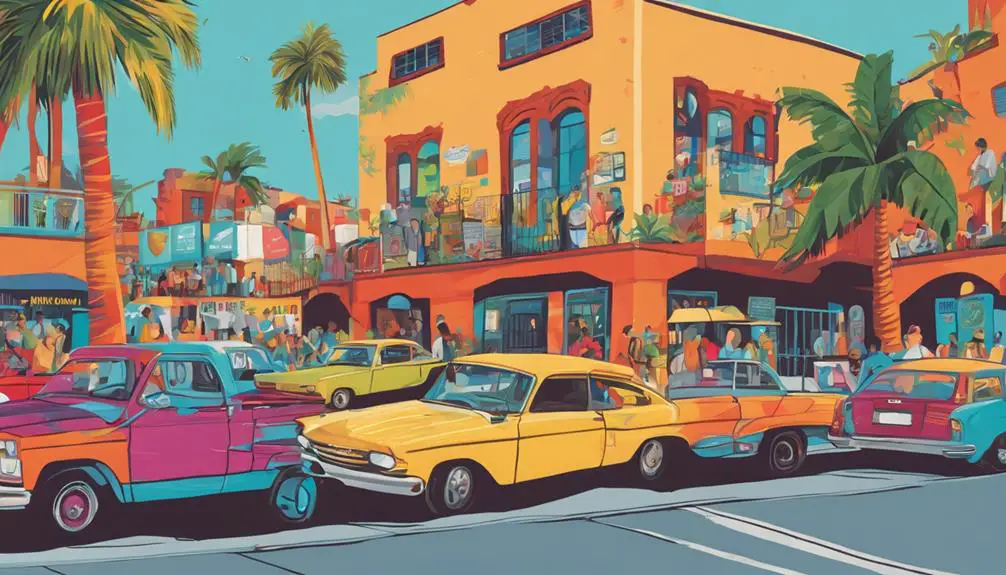When exploring Spanish-speaking cities, you'll need to know key phrases to find parking spots, avoid fines, and communicate with locals. You'll see signs like 'Estacionamiento Prohibido' and 'Sentido Único' – understanding these is essential. Locals use expressions like '¡Está libre!' for available spots and '¡Cuidado con la multa!' for ticketing spots. Asking '¿Dónde puedo aparcar?' is common, and knowing regional slang, like 'aparcar en batería' in Andalusia, can help. As you learn more about parking in Spanish, you'll become more confident in your ability to handle these situations with ease.
Parking Essentials in Spanish

When getting around Spanish-speaking cities, you'll frequently encounter parking signs and instructions that require a basic understanding of Spanish vocabulary and phrases to avoid fines and guarantee a smooth parking experience.
As you navigate through the city, you'll come across various parking signs, such as 'Estacionamiento Prohibido' (No Parking) or 'Zona de Estacionamiento' (Parking Zone). It's important to recognize these signs to avoid parking in restricted areas.
Familiarizing yourself with basic traffic rules is also important. For instance, understanding the phrase 'Sentido Único' (One Way) can help you avoid driving in the wrong direction. Additionally, knowing the phrase ' prohíbido estacionar' (no parking) can save you from receiving a fine.
Colloquial Expressions for Parking
As you explore the intricacies of parking in Spanish-speaking cities, you'll often hear locals using colloquial expressions that can help you find a spot or avoid a fine.
For instance, if you're circling around looking for parking, you might hear someone say '¡Está libre!' (It's free!) to indicate an available spot.
When approaching a crowded street, you might hear '¡Cuidado con la multa!' (Watch out for the fine!) to warn you about a notorious ticketing spot.
Familiarizing yourself with these colloquial expressions can be a valuable parking hack. You'll sound like a local when you ask '¿Dónde puedo aparcar?' (Where can I park?) or '¿Cuánto cuesta aparcar aquí?' (How much does it cost to park here?).
Pay attention to street signs, too, as they often indicate parking restrictions or time limits. Knowing what 'Prohibido estacionar' (No parking) or 'Zona azul' (Blue zone, indicating paid parking) means can save you from a hefty fine.
Regional Parking Slang in Spain

When maneuvering parking in cities like Madrid, Barcelona, or Seville in Spain, encountering distinct regional slang is crucial. Locals use expressions like 'aparcar en batería' in Andalusia or 'quitar el coche' in Catalonia to describe parking strategies.
As you explore the diverse regions of the country, being aware of the linguistic variations that can impact your parking experience is vital.
In Andalusia, the Andalusian dialect dominates, and phrases like 'dejar el coche' (to leave the car) or 'aparcar en batería' (to park in a row) are commonly used.
Meanwhile, in Catalonia, the Catalan nuances are pronounced, and expressions like 'quitar el coche' (to remove the car) or 'aparcar enfila' (to park in a line) are prevalent.
Understanding these regional differences will help you better communicate with locals and avoid misunderstandings when searching for parking spots.
Latin American Parking Lingo
You'll find that Latin American countries have their own distinct parking lingo, which can vary greatly from the regional slang you encountered in Spain. As you navigate the parking culture in Latin America, you'll notice that each country has its unique expressions and phrases.
For instance, in Mexico, you might hear 'estacionamiento' or 'parqueo' to refer to a parking lot, while in Argentina, it's common to say 'estacionar' to park your vehicle.
When driving through Latin American cities, pay attention to street signs that indicate parking restrictions or designated parking areas. You might see signs that say 'Estacionamiento Prohibido' (No Parking) or 'Zona de Estacionamiento' (Parking Zone). Understanding these signs is important to avoid fines or towing.
Latin American countries also have their own parking customs and etiquette. For example, in some cities, it's common to tip parking attendants or 'franeleros' who help guide you into tight parking spots. Be mindful of these cultural nuances to ensure a smooth parking experience in Latin America.
Common Parking Scenarios in Spanish

Three common parking scenarios in Spanish-speaking countries involve finding a parking spot, asking for directions to a parking area, and inquiring about parking rules or fees. You might find yourself in a situation where you need to ask, "¿Dónde está el estacionamiento?" (Where is the parking?) or "¿Cuánto cuesta estacionar aquí?" (How much does it cost to park here?).
| Scenario | Spanish Phrase | English Translation |
|---|---|---|
| Asking for directions to a parking area | ¿Dónde está el estacionamiento? | Where is the parking? |
| Inquiring about parking rules or fees | ¿Cuánto cuesta estacionar aquí? | How much does it cost to park here? |
| Dealing with parking frustrations | Estoy frustrado con este estacionamiento | I'm frustrated with this parking |
| Handling parking emergencies | Necesito ayuda con mi emergencia de estacionamiento | I need help with my parking emergency |
In these situations, being able to communicate effectively in Spanish can help alleviate parking frustrations and even handle parking emergencies. By learning key phrases and vocabulary, you can navigate common parking scenarios with confidence.
Frequently Asked Questions
What Is the Protocol for Parking in a Crowded Spanish City?
When maneuvering through a crowded Spanish city, you'll need to master the art of parking. Start by following local parking etiquette: look for blue lines indicating paid parking zones and respect pedestrian areas.
Use your GPS to locate available spots, and be prepared to traverse narrow streets. When you find a spot, park compactly and considerately, leaving enough space for others.
Are There Designated Parking Spots for People With Disabilities?
As you navigate the bustling streets of a crowded Spanish city, you'll be reassured to know that designated parking spots for people with disabilities are a common sight. You'll spot them easily, marked with the wheelchair symbol and situated close to accessible routes.
To park in these spots, you'll need a valid disability permit, which can be obtained through the Spanish authorities. This thoughtful provision guarantees a seamless experience for all.
Can I Park My RV or Camper Van in a Standard Parking Lot?
When you're planning to park your RV or camper van in a standard parking lot, consider the RV's height and camper clearance. You'll need to guarantee your vehicle fits safely under overhead structures, such as gates or canopies.
Measure your RV's height and check the parking lot's clearance before entering. If you're unsure, it's best to choose a designated RV parking area or contact the lot's management to avoid any potential issues.
How Do I Report a Parking Violation or Dispute a Fine?
When disputing a parking fine, you'll want to act quickly and carefully.
First, review the ticket for any errors, such as incorrect license plate numbers or invalid fine amounts. If you spot a mistake, you can appeal the fine through the issuing authority's Fine Appeals process.
Be prepared to provide evidence supporting your claim, and follow the appeal procedure carefully to guarantee a successful dispute.
Are Parking Meters and Kiosks Typically Bilingual in Spain?
When managing parking in Spain, you'll encounter meters and kiosks, which are typically bilingual, displaying both Spanish and English. This consideration helps minimize language barriers, ensuring you understand payment instructions and parking regulations.
However, it's still possible to experience ticket confusion if you're not familiar with the system. Take a moment to carefully read the signs and instructions to avoid any misunderstandings.
Conclusion
As you navigate the twists and turns of parking in Spanish, remember that mastering the local lingo is the key to accessing a stress-free experience. Think of it as finding the perfect parking spot – it's the culmination of all your efforts coming together in harmony.
With these colloquial expressions, regional slang, and common scenarios under your belt, you'll be parking like a pro in no time, effortlessly gliding into the perfect spot.







